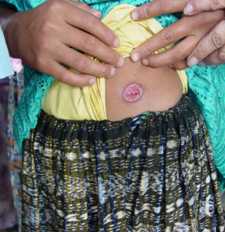Disease

Ulcerative skin lesion, with a raised outer border, on a Guatemalan patient who has cutaneous leishmaniasis. (Credit: B. Arana, MERTU, Guatemala)

Marked splenomegaly (enlargement/swelling of the spleen) in a patient in lowland Nepal who has visceral leishmaniasis. (Credit: C. Bern, CDC)
There are several different forms of leishmaniasis in people. Some people have a silent infection, without any symptoms or signs.
The most common form is cutaneous leishmaniasis, which causes skin sores. The sores typically develop within a few weeks or months of the sand fly bite. The sores can change in size and appearance over time. The sores may start out as papules (bumps) or nodules (lumps) and may end up as ulcers (like a volcano, with a raised edge and central crater); skin ulcers might be covered by scab or crust. The sores usually are painless but can be painful. Some people have swollen glands near the sores (for example, under the arm, if the sores are on the arm or hand).
The other main form is visceral leishmaniasis, which affects several internal organs (usually spleen, liver, and bone marrow) and can be life threatening. The illness typically develops within months (sometimes as long as years) of the sand fly bite. Affected people usually have fever, weight loss, enlargement (swelling) of the spleen and liver, and low blood counts—a low red blood cell count (anemia), a low white blood cell count (leukopenia), and a low platelet count (thrombocytopenia).
Mucosal leishmaniasis is an example of one of the less common forms of leishmaniasis. This form can be a sequela (consequence) of infection with some of the species (types) of the parasite that cause cutaneous leishmaniasis in parts of Latin America: certain types of the parasite might spread from the skin and cause sores in the mucous membranes of the nose (most common location), mouth, or throat. The best way to prevent mucosal leishmaniasis is to ensure adequate treatment of the original cutaneous (skin) infection.
- Page last reviewed: January 10, 2013
- Page last updated: January 10, 2013
- Content source:


 ShareCompartir
ShareCompartir